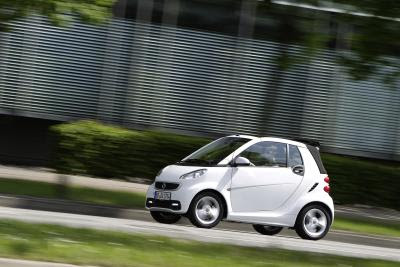In ADAC Crash Test Of Small Cars Smart Fortwo Came Out Tops
When a small car collides with a larger one, the smaller vehicle draws the short straw. This is confirmed by the latest ADAC crash test. With one exception: in this David-and-Goliath clash the smart fortwo was the only small car able to prevent life-threatening injuries to the driver from severe trauma to the chest.
The standard EuroNCAP crash test simulates a frontal collision with a vehicle of the same weight. In contrast, for the first time the ADAC had four smaller models crash into a barrier vehicle equivalent to a lower-end mid-sized car. Further, in this first compatibility crash test the unequally matched parties to the accident collided with an offset of 50 percent. This is because, according to the ADAC, in an accident it is usually vehicles of different weights that collide, usually with a degree of lateral offset.

The horrifying outcome of the crash test is that life-threatening injuries in the chest region are commonplace in smaller vehicles. Only the smart fortwo protected its driver from such injuries – despite being the smallest and lightest vehicle in the test.
According to the ADAC, the reasons for the alarming test results lie partly in the fact that the short crumple zone of smaller vehicles cannot absorb sufficient energy and the forces unleashed during an accident are often not conducted to the corresponding energy-absorbing components.
The smart fortwo owes its good crash test result to an innovative construction based on examinations of actual accident scenarios conducted by Mercedes-Benz Cars as opposed to focusing solely on the requirements of EU and American laws.
Collisions with other vehicles in different constellations were therefore also taken into account during the development phase of the smart fortwo.
Because the constructional crash-safety provisions and restraint systems of all vehicles of Mercedes-Benz Cars satisfy such strict, internal standards that in part go way beyond the statutory requirements, they have also proved themselves in everyday practice, according to Mercedes-Benz, adding that the same goes for the smart fortwo.
In the smart fortwo, the tridion safety cell protects its occupants like the hard shell around a nut. Its structure is additionally reinforced with high-strength and ultra-high-strength steel at strategically important points (more than 50 percent).
Additionally, the tridion safety cell’s longitudinal and transverse members activate the crumple zone of the other vehicle involved in the accident and distribute the impact energy evenly over the car’s body.
And in case of a collision, the wheels also take on the function of crumple zones. When this happens, the front wheels are supported by the side members.
The rear-mounted engine enables a larger crumple zone at the front and acts as a shock-absorbing unit that absorbs the impact energy in a rebound.
Thanks to the sandwich-type construction of the tridion safety cell, the passengers are usually somewhat above the direct danger zone in the event of a side impact. Further, in the case of a side impact, the other vehicle almost always hits an axle that can absorb impact energy due to the relatively short wheelbase.
All interior trims have been optimised to prevent injuries to occupants. And the soft foam-backed lower instrument panel (knee pad) offers protection for the passengers’ knees and lower legs.
Additionally, the door structure is reinforced by high-strength sheet metal at key points.
Other standard safety features in the smart fortwo are ESP with ABS and brake assist (BAS), wide track width, seat belts with belt tensioner and belt-force limiter, safety seats with integral seat belts, airbags.
However, it is not only the smart fortwo driver who benefits: due to its low weight it has little impact on the other vehicle involved in the accident and causes a minimum of damage.
The result of the latest ADAC crash test was summed up by the popular German newspaper “Bild”: “Only the smart is truly smart.”
More and more buyers agree with this opinion. More than 1.4 million smart fortwos have been delivered to customers since the first model was launched in 1998. 101,996 smart fortwos were handed over to customers worldwide in 2011 – 4.6 percent more than in the previous year.
